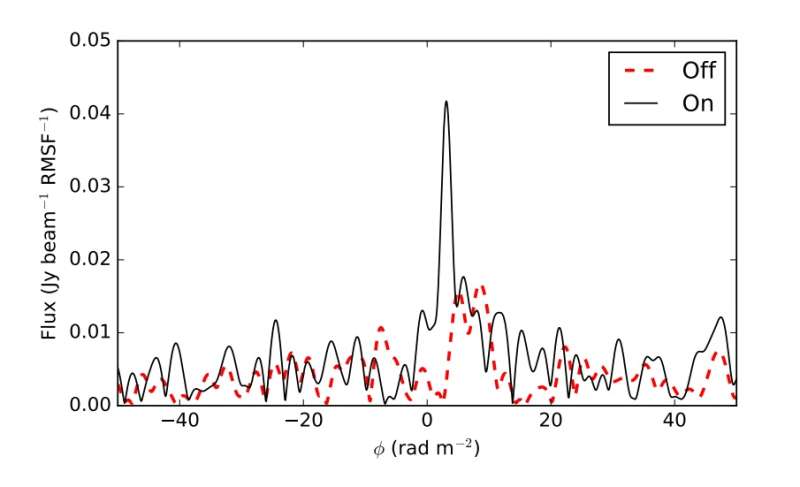February 15, 2017 report
Faint, polarized flares detected from the variable star UV Ceti

(Phys.org)—Astronomers have detected four faint, polarized flares at 154 MHz from the nearby variable star UV Ceti. The newly observed flares are much fainter than most flares found at these frequencies. The findings were presented February 10 in a paper published online on the arXiv pre-print server.
Located just about 8.7 light years away, UV Ceti, or Luyten 726-8B, belongs to a nearby binary star system Luyten 726-8. It is a variable red dwarf of spectral type M, just like its companion star BL Ceti (Luyten 726-8A). Due to its proximity, this star system is a treasure trove for astronomers studying flaring events of magnetically active stellar systems.
That is why a team of researchers led by Christene Lynch of the University of Sydney in Australia selected UV Ceti as a target of radio astronomy observations in December 2015. They used the Murchison Widefield Array (MWA) in Australia to confirm previous bright flare detections in the system at 100 to 200 MHz. The array allowed the scientist to get a glimpse of low-level flares fainter than expected.
"We have detected four flares from UV Ceti at 154 MHz using the Murchison Widefield Array," the paper reads.
The observation sessions, which used a 30.72 MHz bandwidth centered at 154 MHz with 40 kHz channels and 0.5-second integrations, allowed the team to observe flare emission in the polarized images. In each epoch, they detected a single right-handed circularly polarized flare, finding also a left-handed flare immediately following the right-handed one. Moreover, they detected linear polarization during the brightest flare, what indicates that the flares are elliptically polarized. The researchers noted that these results highlight the importance of polarization images in such studies.
"These dim flares are only detected in polarized images, which have an order of magnitude better sensitivity than the total intensity images. This highlights the utility of using polarization images to detect low level emission in confusion limited images," the team wrote in the paper.
The study also revealed that the newly detected flares have flux densities between 10 to 65 mJy. This means that they are about 100 times fainter than most flares observed so far at similar frequencies. Notably, three of the four flares described in the paper have flux densities below 15 mJy, while the one observed on Dec. 11, 2015 reached nearly 65 mJy.
The researchers emphasize that their study provides first flare rate measurements for low-intensity (below 100 mJy) flares at 100 to 200 MHz. However, they note that there is still much to accomplish in the field of flare emission research and recommend further observations. Future studies would improve our understanding of physical parameters of the stellar magnetospheric plasma.
"To better characterize M dwarf flares at meter wavelengths requires more observational time on individual sources to constrain flare rates. More sensitive observations are also needed to investigate the fine time-frequency structure of the flares. Simultaneous multi-wavelength observations would also add to this analysis," the team concluded.
More information: 154 MHz detection of faint, polarized flares from UV Ceti, arXiv:1702.03030 [astro-ph.SR] arxiv.org/abs/1702.03030
Abstract
We have detected four flares from UV Ceti at 154 MHz using the Murchison Widefield Array. The flares have flux densities between 10—65 mJy —- a factor of 100 fainter than most flares in the literature at these frequencies —- and are only detected in polarization. The circular polarized fractions are limited to >27% at 3σ confidence and two of the flares exhibit polarity reversal. We suggest that these flares occur periodically on a time scale consistent with the rotational period of UV Ceti. During the brightest observed flare, we also detect significant linear polarization with polarization fraction >18%. Averaging the data in 6-minute, 10 MHz frequency bins we find that the flux density of these flares does not vary over the 30 MHz bandwidth of the Murchison Widefield Array, however we cannot rule out finer time-frequency structure. Using the measured flux densities for the flares, we estimate brightness temperatures between (1013−1014)K, indicative of a coherent emission mechanism. The brightness temperature and polarization characteristics point to the electron cyclotron maser mechanism. We also calculate the flare rates given our four observed flares and compare them to flare rates for the set of M dwarf stars with known 100—200 MHz flares. Our measurement is the first for flares with intensities <100 mJy at 100-200 MHz.
© 2017 Phys.org





















